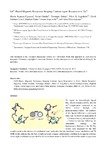Gd3+-based magnetic resonance imaging contrast agent responsive to Zn2+

View/
Use this link to cite
http://hdl.handle.net/2183/18350Collections
- Investigación (FCIE) [1228]
Metadata
Show full item recordTitle
Gd3+-based magnetic resonance imaging contrast agent responsive to Zn2+Author(s)
Date
2015-10-15Citation
Gd3+-Based Magnetic Resonance Imaging Contrast Agent Responsive to Zn2+. Martín Regueiro-Figueroa, Serhat Gündüz, Véronique Patinec, Nikos K. Logothetis, David Esteban-Gómez, Raphaël Tripier, Goran Angelovski, and Carlos Platas-Iglesias. Inorganic Chemistry 2015 54 (21), 10342-10350 DOI: 10.1021/acs.inorgchem.5b01719
Abstract
[Abstract] We report the heteroditopic ligand H5L, which contains a DO3A unit for Gd3+ complexation connected to an NO2A moiety through a N-propylacetamide linker. The synthesis of the ligand followed a convergent route that involved the preparation of 1,4-bis(tert-butoxycarbonylmethyl)-1,4,7-triazacyclononane following the orthoamide strategy. The luminescence lifetimes of the Tb(5D4) excited state measured for the TbL complex point to the absence of coordinated water molecules. Density functional theory calculations and 1H NMR studies indicate that the EuL complex presents a square antiprismatic coordination in aqueous solution, where eight coordination is provided by the seven donor atoms of the DO3A unit and the amide oxygen atom
of the N-propylacetamide linker. Addition of Zn2+ to aqueous solutions of the TbL complex provokes a decrease of the emission intensity as the emission lifetime becomes shorter, which is a consequence of the coordination of a water molecule to the Tb3+ ion upon Zn2+binding to the NO2A moiety. The relaxivity of the GdL complex recorded at 7 T (25 °C) increases by almost 150% in the presence of 1 equiv of Zn2+, while Ca2+ and Mg2+ induced very small relaxivity changes. In vitro magnetic resonance imaging experiments confirmed the ability of GdL to provide response to the presence of Zn2+.
Keywords
Contrast agents
Coordination compounds
Gadolinium
Lanthanides
NMR imaging
Coordination compounds
Gadolinium
Lanthanides
NMR imaging
Editor version
Rights
This document is the Accepted Manuscript version of a Published Work that appeared in final form in "Inorganic Chemistry", copyright © American Chemical Society after peer review and technical editing by the publisher.
ISSN
0020-1669
1520-510X
1520-510X





